■あのモン・サン=ミシェルに「ジャンヌ・ダルク像」があった。
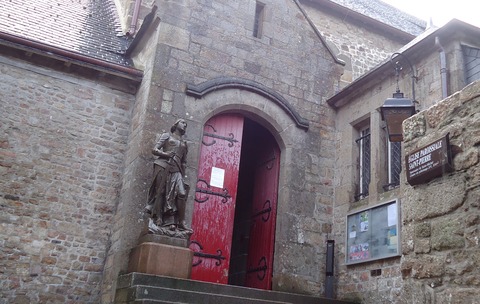
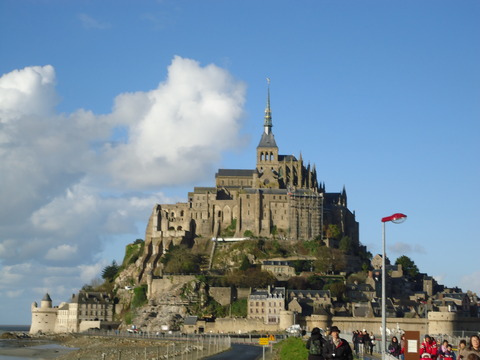
フランスを旅行すると、「ジャンヌ・ダルク像」は各地で見かけますが、意外なところで「ジャンヌ・ダルク像」と対面することがあります。私が驚いたのは、モン・サン=ミシェルの中の小さな教会、サン・ピエール教会の入り口にある甲冑姿の「ジャンヌ・ダルク像」でした。修道院を目指して急な石段を上っていると、つい見逃してしまいそうな像です。「どうしてこんなところにジャンヌ・ダルク像があるのか」と思ったのですが、モン・サン=ミシェル自体、708年、当時の司教が大天使ミカエルのお告げを受けて礼拝堂を作ったと伝えられることから、同じように大天使ミカエルのお告げを受けたという「ジャンヌ・ダルク」の像を置いたものでしょうね。
■大天使ミカエルからお告げを受けた13歳の「ジャンヌ・ダルク」。 
フランスを象徴する英雄と言えば、真っ先にあがるのは、ナポレオン・ボナパルトということになりそうですが、人気の方から言えば、何と言ってもこの「ジャンヌ・ダルク」でしょうね。「ジャンヌ・ダルク」は、1412年、貧しい農家の少女として生まれました。平凡な少女時代を送っていましたが、1425年、13歳のとき、大天使ミカエルなどから啓示を受けます。「ジャンヌよ、これからは私の指示に従うのだ。お前は、敵軍をフランス領土から駆逐し、王太子シャルルをランスで戴冠させるのだ」と。
■100年戦争の真っただ中、オルレアンの町は包囲されていた。
フランスは、このころ、ちょうどイングランドとの百年戦争の真っただ中。長い戦乱により国内は荒れ果てていました。しかも、1415年には、イングランド王ヘンリー5世が北フランスに侵攻し、フランス軍に大勝。ところがヘンリー5世の急死に伴い、生まれたばかりのヘンリー6世にイングランド王位とあわせて、フランス王位を継承させることになりました。イングランド王がフランス王をも名乗るありさまでした。一方、王太子シャルル(本来のフランス王シャルル7世)は、南フランスではフランス王を称していましたが、正式な形で、フランス王として即位できないでいました。1428年、イングランド軍は中部フランスの要地オルレアンを攻撃。半年間の包囲を経て、町は絶望的な状態に追い詰められていました。
この時、「オルレアンの包囲を解いて王太子シャルルをランスで戴冠させるため、王太子の元へ行く」と言う少女が現れました。これが、世に言う「オルレアンの少女」、ジャンヌ・ダルクだったというわけです。1428年、少女は17歳、「シノンの町にいる王太子シャルルの元に赴くように」という神の啓示を受けたとして、隣町ヴォークールールの守備隊長ロベール・ド・ボードリクールにとりなしを依頼します。隊長は部下5人を護衛に付けてくれました。神の啓示を受けたという少女ジャンヌの「オーラ」がそうさせたのか、ジャンヌは王太子シャルルと面会することができました。そして、王太子シャルルは、3週間に及ぶ審理を経て、彼女に「貴族出身の司令官と同等の待遇」を与えることにしたのです。
■「シャルル7世戴冠」は成功したが、「ジャンヌ・ダルク」は捕えられた。
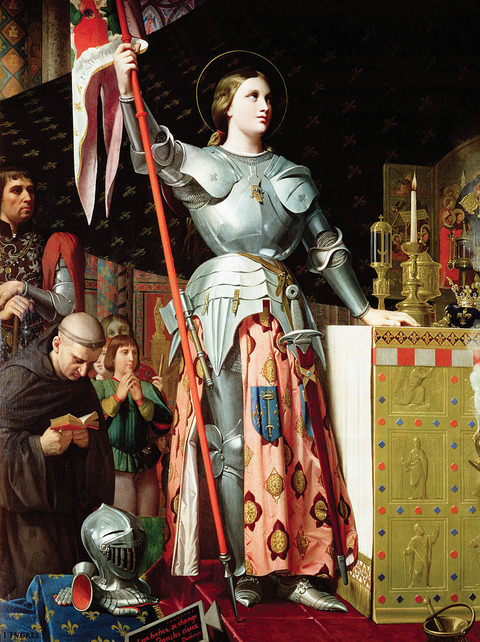
1429年3月、ジャンヌは白い甲冑を身につけて、白馬に乗ってオルレアンに向けて出発しました。オルレアンの町は、イングランド軍に包囲されていました。フランス軍は、4月に入ると、町の西門を守るイングランド軍に攻撃の火ぶたを切りました。その間に、東門からオルレアンの町に入ったジャンヌは、イングランド軍に何回も攻撃を繰り返し、5月には、町の包囲を解き、ついにイングランド軍を撤退させました。1429年7月、王太子シャルルはランスのノートルダム大聖堂で、晴れてシャルル7世としてフランス王位に就いたのです。ジャンヌは、この勢いに乗ってパリを奪還すべきだと主張しましたが、シャルル7世は、「ジャンヌは力を持ち過ぎているのでは」との側近の警告を聞いて、決意に迷いが生じたのでした。1430年5月、イングランド軍に味方するブルゴーニュ派とのコンピエーニュの戦いで、ジャンヌは捕えられ、イングランド軍に売り渡されてしまいます。このとき、シャルル7世は、ジャンヌを救出する積極的な努力をしなかった、と今でも非難されることがあります。
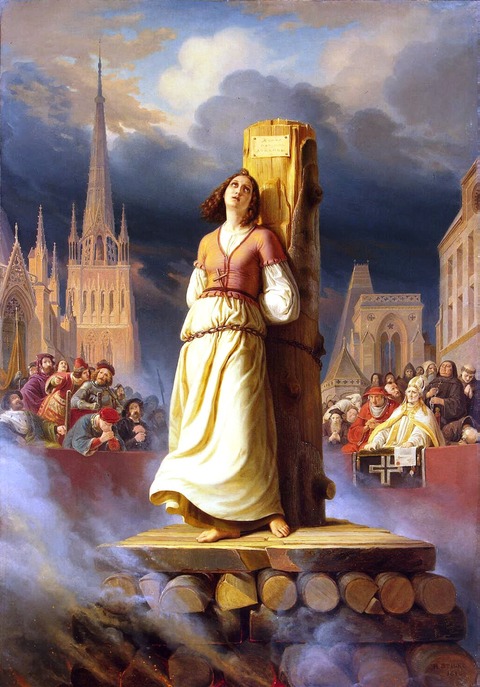
ジャンヌは5カ月もの間牢獄に閉じ込められたあげく、イングランド軍の本拠地ルーアンで、虚偽の啓示を謳った異端者として、異端裁判にかけられました。裁判結果は、「火刑に処す」という最高刑でした。処刑を目撃した人によれば、ジャンヌは、火刑台の上から十字架を求め、炎の中で「イエス様」と6回叫びながら、19歳の短い生涯を閉じました。1431年5月30日のことでした。しかし、ジャンヌの死後の名声は、フランスを救った偉大な英雄として高まる一方でした。それから25年後、異端審問官長のジャン・ブレアルとジャンヌの母親の要請で裁判はやり直され、ジャンヌの名誉は回復。そして、長い時を経て、1909年列福、1919年、列聖され、ジャンヌは500年に近い時を経て、初めて「聖人」として認められることになるのです。

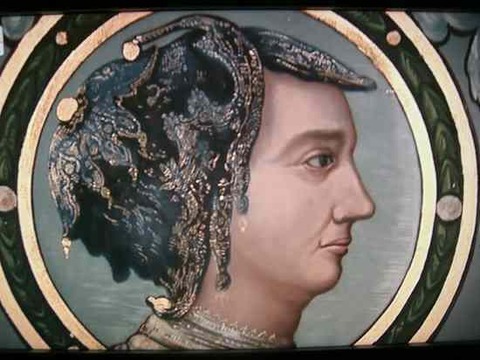

ジャンヌの死後、何人かの偽物が現れたのは事実のようです。「なりすまし」成功例として、多くの著書に出てくるのは、クロード・デ・ザルモアーズという人物です。ジャンヌが処刑されてから5年後の1436年のこと、何と「ジャンヌ・ダルク」を名乗る女性が突然フランスのロレーヌ地方に現れたというのです。「本当なのか」ということで、その女性は、ジャンヌの実の兄2人と面会させられましたが、2人の兄は「あの女性は、間違いなく、妹のジャンヌ本人だ」と認めたと言います。このため、女性は、ロレーヌ地方のメスという町で「フランスを救った英雄」として熱烈な歓迎を受けました。1436年の秋、女性は何と、領主であるロベール・デ・ザルモアーズという人物と結婚までしています。女性は、シャルル7世とも面会しますが、自分は偽物だとあっさり認めてしまいます。ところが、シャルル7世はこれを許し、結局夫の城で余生を送ったといいます。 しかし、一方で、異なる結論に至る話もあります。裁判所が一度処刑の判決を下した人物が、実は生きていたとなると、裁判所の面子は丸潰れとなります。そこで裁判所は、この女性に1440年出廷命令を出します。ところが、その後女性は突然失踪し、それから二度と姿を現わすことはありませんでした。この話は、クロード・デ・ザルモアーズの「なりすまし」の半分成功例ですね。
■「ジャンヌ・ダルク」は身代わりを立てて生き延びた?

さて、このほかさまざまな、「ジャンヌ・ダルク」死後の後日談や陰謀説もあるようですが、本当のところ、ジャンヌは火刑を生き延びたのでしょうか。やり直しの裁判では、火刑に立ち会って、ジャンヌ本人だと確認したという数多くの署名もあるようです。しかし、現代と違って、科学的な「本人認証システム」があるわけではありませんから、身代わりを立てて生き延びたという可能性が全くない、とは言えません。たとえば「十字架に架けられたイエス・キリストは実は別人で、本人は生き延びていた」というような伝説も数多くあります。「ジャンヌ・ダルク」本人も、実際は火刑の直前に身代わりを立てて生き延びたのかもしれません。フランス人がそうであるように、私の中にも、「ジャンヌの悲劇的な最期は受け入れがたい」という気持ちがあるようです。「なんとか生き延びていて欲しい」という願望を持つのは、私だけではないでしょうね。
(出典、参考)
the guardian、やりすぎ都市伝説、アンティークアナスタシア、HISTORIC MYSTERIES、Mysteries of The Maid of Orleans - a new book、pravd.ru、不思議館、The Purple Chamber、livescience,SAMUEL FRENCH、The Telegraph、MEDIEVALISTS.NET, Wikipedia
While traveling in France, we can see “St. Joan of Arc Statues” anywhere, but we happen to meet her statue in an unexpected place. I was surprised to see her statue at Mont Saint Michel on my way to Paris. Looking gallant in her armour, it stood there beside the entrance of St. Pierre’s Church, a small church located on the island of Mont Saint Michel. It was such a low-key statue that I almost missed it because I was just ascending the steep flight of stone steps to the Norman Benedictine Abbey at the peak of the rocky island. Then I wondered why Joan of Arc Statue was placed in such a place. According to a legend, a bishop of the time built the chapel on the island because St. Michael the Archangel was quoted as saying to him that his mission was to build a chapel on the island. Following the bishop’s precedent, someone perhaps placed the statue of Joan of Arc who likewise had a revelation from St. Michael the Archangel.
■Joan had her first revelation from St. Michael the Archangel.
If asked about the historical hero emblematic of France, many French people first may give the name of “Napoleon Bonaparte”, but I believe it is “Saint Joan of Arc” (or in French, Jeanne d’Arc), the Maid of Orleans, who has ever been their regular favorite heroine in France. Born around 1412, Joan of Arc was the daughter of a tenant farmer, her father Jacques d’Arc in the village of Domremy in northeastern France. In 1425, when she was thirteen years of age, she saw visions of Saint Michael, Saint Catherine and Saint Margaret, who told her to follow their counsel, drive out the English from French territory and bring the Dauphin Charles (the uncrowned prince Charles of Valois) to Reims in northern France for his coronation.
■The city of Orleans was besieged by English forces.
France was in the midst of the Hundred Years’ War, a series of wars between England and France. The whole French land was just in ruins. In 1415, Henry V of England made inroads into the northern French territory, besieged the fortress at Harfleur, captured it, and led to a major English victory at the Battle of Agincourt. Curiously enough, however, Henry V died suddenly. In the wake of his death, the House of Lancaster decided to let his newborn child accede to the throne of King of England as well as King of France. This means that King of England also proclaimed himself King of France. On the other hand, the embattled uncrowned prince Charles of Valois took the name of King of France in southern France, but he officially remained uncrowned as King of France. In 1428, the English forces assaulted the city of Orleans, the strategically key position in central France. The city was just driven to the last ditch after it was besieged for six months.
■Joan was appointed as a commanding officer.
Around this time there appeared a teenage girl who claimed her divine mission to have an audience with the Dauphin Charles because she had a revelation from God to lift the siege of Orleans and bring him to Reims for his coronation, the city in which the French kings were traditionally crowned. She was, quote-unquote, the Maid of Orleans who became famous worldwide as Joan of Arc. In 1428, when she was seventeen years of age, she demanded that the garrison commander at Vaucouleurs, Robert de Baudricourt, should bring her to see the Dauphin Charles in Chinon. He granted an escourt of five veteran soldiers who successfully took her to Chinon. Perhaps something like a divine “aura” around the teenage girl who experienced divine revelations allowed her to meet the Dauphin Charles. After she was investigated to determine whether she was a heretic, the churchmen concluded that she was of sound mind and that her claims were true. Judging from their conclusion, Charles gave her command of a small force of French soldiers.
■Charles was crowned in Reims, but Joan was captured.
In March, 1429, Joan set off for Orleans dressed in white armor and riding a white horse. The city was under siege by English forces. In April, French troops launched an attack on the English troops defending the city’s west gate. Joan entered Orleans’ east gate and launched a number of strikes on the English forces. In May, the Orleans’ siege was raised, and finally the English forces retreated. On 17th July, 1429, Charles was formally crowned as King Charles VII of France in Reims Cathedral (Notre-Dame de Reims, Our Lady of Reims). Joan argued that the French troops should press their advantage with an attempt to retake Paris, but Charles wavered because his favorite at court warned him that Joan was becoming too powerful. In May, 1430, the Burgundians taking sides with the English took Joan captive at the siege of Compiègne, and finally sold her to the English. Some people still claim that Charles VII should be criticized for having left Joan in the lurch without any active efforts to negotiate her release.
■Joan was burned at the stake at the young age of nineteen years.
After five months in captivity, Joan was put on trial for witchcraft and heresy in Rouen, the home city of the English troops. The clergy gave her the maximum sentence of being burned at the stake. According to eyewitnesses who saw the scene of Joan’s execution, on May 30th, 1431, while engulfed in flames, Joan asked for a cross to be held before her and cried out the name of the Lord Jesus six times. Her short life was ended at the young age of nineteen. However, her fame only increased after her death as a great heroin who saved France. 25 years after her death, Joan of Arc’s posthumous retrial was held at the request of Inquisitor-General Jean Bréhal and her mother Isabelle Romée. Finally her honor was vindicated. After a long period of time, the efforts of Félix Dupanloup, bishop of Orléans, culminated in Joan’s beautification in 1909, and Pope Benedict XV canonized Joan in 1920. Over a long time - approximately half a century - Joan officially became recognized as a saint.
It appears to be a simple fact that several impostors claiming to be Joan of Arc appeared after Joan’s death. As a successful case of “Joan impostor”, the woman named “Claude de Armoises” has been mentioned in many writings. The story goes that it was in 1436 - five years after Joan’s execution. Believe or not, there suddenly appeared a woman calling herself “Joan of Arc” in a village near Metz, France. Many villagers were skeptical about her authenticity, but two of Joan’s brothers went to see the woman and firmly declared that the young lady was, indeed, their own sister. Thus, the woman received an enthusiastic welcome from the people in the town of Metz - as a great heroine who saved France. Surprisingly, in autumn, 1436, the woman married the knight Robert des Armoises. She had an audience with Charles VII, but she readily confessed that she was not Joan, but Joan’s impostor. In a strange twist, Charles VII granted her confession, and Claude de Armoises , who lived out the rest of her life in her husband’s castle, died at the age of 57 years. On the other hand, however, some stories have a different ending. If Joan found guilty of witchcraft and heresy had survived, the clergymen of the time would have completely lost face. Thus, they tried to summon the woman to court in 1440, but she absconded somewhere without any prior notice. No one has ever seen her since then. We could argue that this was a half-successful case of “Claude de Armoises”.
Anyway, there are a variety of conspiracy theories on Joan’s life, and many sequels to Joan’s tragic end, but did Joan actually survive the fire? The posthumous trial for Joan appears to have recorded sworn testimony from numerous witnesses who were present at the execution and who confirmed her identity. There was no scientific “personal identification system” available in the 15th century, so we could never conclude that Joan had no chance of surviving the execution. There are so many “scapegoat” legends - for example, one of them says, ”Jesus put on the Cross was someone else other than Jesus. Actually Jesus lived out the rest of His life.” In my heart of hearts I feel that Joan of Arc’s unfortunate end is also difficult to accept just as French people might do. I’d like to believe I’m not the only one who wishes that Joan had escaped the stake and could have lived out the rest of her life.
(Sources, References)
the guardian, HISTORIC MYSTERIES, Mysteries of The Maid of Orlean - a new book, The Purple Chamber, livescience, SAMUEL FRENCH, The Telegraph, THIS DAY IN HISTORY, In Joan of Arc’s Footsteps, ROMAN CATHOLIC SAINTS, MEDIEVALISTS.NET, Wikipedia

コメント
コメント一覧 (1)
https://www.youtube.com/watch?v=TR39mnR2HWo